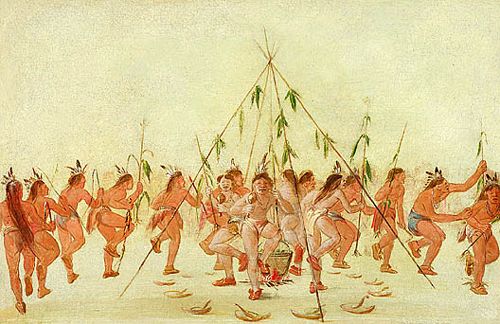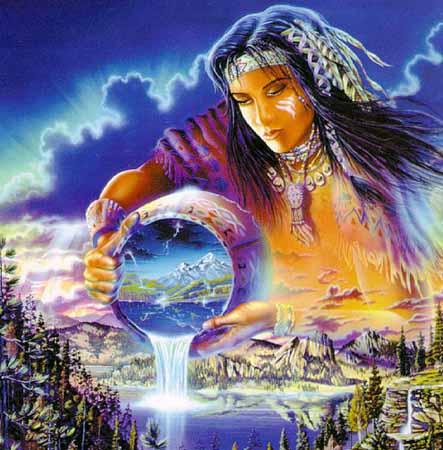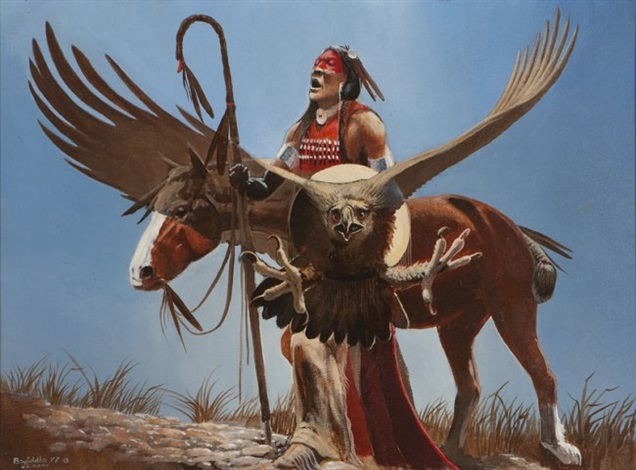 A Kind of Magic: Ritual, Ceremony and Prayer in Early America
A Kind of Magic: Ritual, Ceremony and Prayer in Early America
Another reason why explorers, and later, settlers, regarded the various Native American peoples as “savage” and “uncivilised” and “heathen” was that they could not, or would not, understand the processes by which these people lived. To a people who believed all of nature was tied together, that man was not all that far above the animals - that they, as mentioned, willingly gave themselves up to the human hunters thanks to the proper rituals being observed - and that even the grass and the trees and the sky had to be respected, it was vitally important that the proper ceremonial offerings be made, not only to ensure good hunting but to reaffirm their bond with animals, plants, the rocks and the earth, the trees and the rivers and the sky. A working dogma for almost every Native American tribe could have been “all is one”. They certainly believed themselves superior to animals, but only because the Great Spirit said so, and not in the same way as we do. We believe animals are there for our use and have no say in the matter. Native Americans worked on a sort of symbiotic relationship with, well, everything, but especially the animals they hunted.
It is a matter of huge hypocrisy (not that religion isn’t based on the nastiest and most violent form of hypocrisy anyway) that Spanish missionaries, and later English, German and others, took offence at the “barbaric” rituals observed by the various Native American tribes. In effect, what the people of America were doing when settlers first encountered them is exactly what those settlers were doing themselves, just in a more overt, and some would say honest way. What was the first thing Christopher Columbus reportedly did when he set foot on the land that would be known as America, and which he believed to be the West Indies? Knelt down and thanked God. To a higher civilisation, would this not be seen as a pointless, savage, uneducated ritual? What role had God played in their adventures? How could they believe he had guided them to their destination? Faith alone drove them, and this same faith in their gods was what spurred the Native Americans to be respectful and careful in their dealings with all other creatures.
However, having given thanks to his god, it was not so very long before Columbus was killing and making slaves of these new peoples, taking their resources and, quite literally, claiming their land in the name of his sovereigns. Native Americans made no such claims, and generally once they had made peace with or come to friendly terms with another people or tribe, kept those promises, which is why it must have seemed like such an amazing and disheartening betrayal to them when the men from across the sea did not keep their word, and this would forever colour the relationship between the two civilisations, the white man never failing to live down to the expectations of the red, culminating in the culling and ethnic cleansing of the latter by the former, and their subjugation as little better than slaves.
 Fantastic Journey: The Vision Quest in Native American Belief
Fantastic Journey: The Vision Quest in Native American Belief
Although they would of course see many rituals, dances and other ceremonies be enacted while young, the first real encounter a Native American male would have with the actual powers that his people believed ruled and ordered their world would be through the medium of the vision quest. This word has, like Iroquois for those people, some distasteful connotations, as it is not the word they use for the spiritual journey, but in the world of the white man it has become more or less accepted as the umbrella catch-all term for what is a sacred rite of passage for Narive American youths, and so you’ll forgive me if I use it. What it’s called is though not as important as what it signifies, which is much more than a farewell to adolescence and ascension to adulthood in the nature of a boy’s first car, or kiss, or even the first time he has to be bailed out of jail. The vision quest was the point at which the boy’s future was, literally decided, revealed to him, his path in life laid out before him by the spirits of his ancestors and the gods, who would often appear in animal form, and came to be known as spirit guides and spirit animals.
In order to get a better understanding of the ideas behind the rituals of the Native Americans, particularly that of the vision quest, I’ve turned to Lee Irwin’s
Dream Seekers: the Native American Visionary Traditions of the Great Plains, and here’s how he or she describes how the Natives saw and interacted with the world:
“One of the most fundamental aspects of the Plains religious topology is its implicit, undivided wholeness. This wholeness institutes the interactive relationships between many beings, both visible and invisible, whose homes are identified with particular ecological environments. The center of this wholeness is the earth itself, regarded as a living being-usually (but not always) a life-giving female. Human beings, the "two* leggeds," live on the earth in shared relationships with all other living creatures, particularly grazing and herding animals- the "'four-leggeds" or "grass-eaters." Below, or perhaps more accurately, within both the earth and the water, is another group of beings with special or unique abilities.
Above, yet another group of beings extends from the earth up through the sky, the home of the "wingeds," and into the celestial realm of the sun, moon, and stars. Thus there are three interpenetrating strata and their respective realms that constitute the wholeness of the natural world: the above realm, the middle realm, and the below realm. The relationship between these realms can best be described topologically as a distinctive contrast, more or less emphasized, between the above and the below, with the middle representing the mysterious realm in which all beings meet and interact.”
So if you followed all of that (wouldn’t blame you if you didn’t) it seems that the spirit world, to the Native Americans, was not some vague half-formed idea of Paradise or the afterlife as we know it, or indeed a vast drinking-hall to which entry was only granted if a Viking died a glorious death, or even the dark, murky world of terrifying more after-death than afterlife the ancient Greeks waited in fear of being called to. For the Native Americans, the spiritual world and the “real” world, the world of the now, the world they lived in, existed both independently and co-dependently. If you sinned in this one, your actions had - usually dire - consequences in the other. Your ancestors were watching you, not as some idea of ghosts floating about, but really, truly there, watching from the world to which they had gone after death, and to which you too must pass when your life was over. You did not want to upset them, and you really wanted to make them proud.

However, what I read tends to give me the idea that a vision quest was not the sort of meditation till you attain Nirvana kind of thing we might suppose, and more the idea of someone, quite young, who was seeking his way in life, looking for meaning and purpose, and seeking advice from his much older ancestors, in the way a young man might turn to his father or grandfather to dispense his wisdom of the world. Nor were these quests simply completed. Irwin titles the chapter which deals with them “Isolation and Suffering”, and so it was. The young warrior would be taken, or be directed to a place of solitude, usually a sacred place, there to remain for several days without food or water, praying and endeavouring to make contact with, be noticed by or form a relationship with the spirits. When one of these deigned to impart its wisdom and power, it most usually took the form of some animal, which was thereafter sacred to and connected with the individual. Often, the “spirit animal” would present the quester with items - special plants, herbs, songs etc - which would then aid his path through life.
Most often, these vision quests would take place on a hill or other high ground, often one sacred to a particular spirit, the idea being to get as close as possible to the spirit world, and also to make the quester visible to those who dwelt above by raising himself above ground level. The quest was usually undertaken in spring, as this was seen as a time of renewal and rebirth, when the spirits were at their most potent. Seen, too, as a time when animals and plants who had been hibernating or sleeping through the winter would wake up and again “come alive”, there could be no doubt about the strong symbolism of spring, and its power.